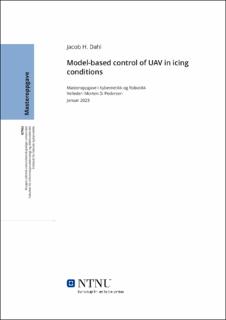| dc.contributor.advisor | Pedersen, Morten D. | |
| dc.contributor.author | Dahl, Jacob H. | |
| dc.date.accessioned | 2023-05-06T17:19:31Z | |
| dc.date.available | 2023-05-06T17:19:31Z | |
| dc.date.issued | 2023 | |
| dc.identifier | no.ntnu:inspera:124179917:51098053 | |
| dc.identifier.uri | https://hdl.handle.net/11250/3066659 | |
| dc.description.abstract | Den eksponensielle økningen av datakraft over de siste tiår har gjort datadrevne algoritmer mer og mer vanlig i et mangfold av applikasjoner, inkludert kontrollsystemer. Modellbaserte kontrollsystemer anvender en modell av systemet de er ment å kontrollere. Tradisjonelt er dette gjort ved modellering via fysikkens lover of matematisk modelleringsprinsipper, men datadrevne metoder tillater bruk av data til å finne ønskede modeller i steden.
Denne oppgaven implementerer en SINDy estimator med mål om å bruke estimatoren på en dynamic-inversion-kontroller for å kontrollere stampraten (pitch rate) til en UAV. Modellen er så evaluert i simulering av et luftfartøy i tre forskjellige scenarioer: ren aerofoil, fullt iset aerofoil, og overgangen mellom dem. | |
| dc.description.abstract | With the exponential increase in computer power over the last decades, data-driven algorithms have become more and more common in different applications. This includes control systems. Model-based control systems require a model of the plants they are intended to control. Traditionally, this was done using the laws of physics and mathematically modelling, but data-driven methods allow for the use of data to find the desired model instead.
This thesis implements a SINDy estimator. With the goal of applying the estimated model on a dynamic inversion controller to control the pitch rate of an UAV. This model is then evaluated in simulation of an aircraft under three different scenarios: clean airfoil, fully iced airfoil, and the transition between them. | |
| dc.language | eng | |
| dc.publisher | NTNU | |
| dc.title | Model-based control of UAV in icing
conditions | |
| dc.type | Master thesis | |
